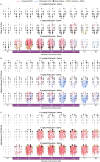This is a preprint.
Psilocybin induces dose-dependent changes in functional network organization in rat cortex
- PMID: 38405722
- PMCID: PMC10888735
- DOI: 10.1101/2024.02.09.579718
Psilocybin induces dose-dependent changes in functional network organization in rat cortex
Update in
-
Intravenous psilocybin induces dose-dependent changes in functional network organization in rat cortex.Transl Psychiatry. 2025 Mar 25;15(1):93. doi: 10.1038/s41398-025-03308-4. Transl Psychiatry. 2025. PMID: 40128190 Free PMC article.
Abstract
Psilocybin produces an altered state of consciousness in humans and is associated with complex spatiotemporal changes in brain networks. Given the emphasis on rodent models for mechanistic studies, there is a need for characterization of the effect of psilocybin on brain-wide network dynamics. Previous rodent studies of psychedelics, using electroencephalogram, have primarily been done with sparse electrode arrays that offered limited spatial resolution precluding network level analysis, and have been restricted to lower gamma frequencies. Therefore, in the study, we used electroencephalographic recordings from 27 sites (electrodes) across rat cortex (n=6 male, 6 female) to characterize the effect of psilocybin (0.1 mg/kg, 1 mg/kg, and 10 mg/kg delivered over an hour) on network organization as inferred through changes in node degree (index of network density) and connection strength (weighted phase-lag index). The removal of aperiodic component from the electroencephalogram localized the primary oscillatory changes to theta (4-10 Hz), medium gamma (70-110 Hz), and high gamma (110-150 Hz) bands, which were used for the network analysis. Additionally, we determined the concurrent changes in theta-gamma phase-amplitude coupling. We report that psilocybin, in a dose-dependent manner, 1) disrupted theta-gamma coupling [p<0.05], 2) increased frontal high gamma connectivity [p<0.05] and posterior theta connectivity [p≤0.049], and 3) increased frontal high gamma [p<0.05] and posterior theta [p≤0.046] network density. The medium gamma frontoparietal connectivity showed a nonlinear relationship with psilocybin dose. Our results suggest that high-frequency network organization, decoupled from local theta-phase, may be an important signature of psilocybin-induced non-ordinary state of consciousness.
Keywords: High gamma oscillations; Phase-Amplitude Coupling; Psilocybin; Psychedelic; Rat; weighted Phase-Lag Index.
Conflict of interest statement
Declaration of interest: Jim Gilligan, Ph.D. is President & Chief Scientific Officer at Tryp Therapeutics. Peter Guzzo, PhD is Consulting VP, Drug Development at Tryp Therapeutics.
Figures





References
Publication types
Grants and funding
LinkOut - more resources
Full Text Sources
